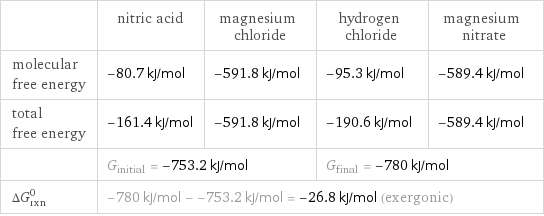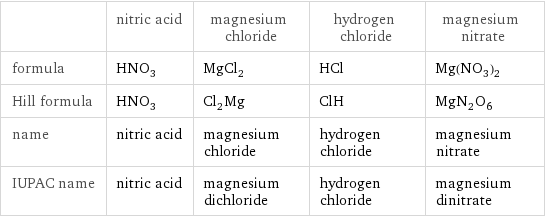Input interpretation

HNO_3 nitric acid + MgCl_2 magnesium chloride ⟶ HCl hydrogen chloride + Mg(NO_3)_2 magnesium nitrate
Balanced equation

Balance the chemical equation algebraically: HNO_3 + MgCl_2 ⟶ HCl + Mg(NO_3)_2 Add stoichiometric coefficients, c_i, to the reactants and products: c_1 HNO_3 + c_2 MgCl_2 ⟶ c_3 HCl + c_4 Mg(NO_3)_2 Set the number of atoms in the reactants equal to the number of atoms in the products for H, N, O, Cl and Mg: H: | c_1 = c_3 N: | c_1 = 2 c_4 O: | 3 c_1 = 6 c_4 Cl: | 2 c_2 = c_3 Mg: | c_2 = c_4 Since the coefficients are relative quantities and underdetermined, choose a coefficient to set arbitrarily. To keep the coefficients small, the arbitrary value is ordinarily one. For instance, set c_2 = 1 and solve the system of equations for the remaining coefficients: c_1 = 2 c_2 = 1 c_3 = 2 c_4 = 1 Substitute the coefficients into the chemical reaction to obtain the balanced equation: Answer: | | 2 HNO_3 + MgCl_2 ⟶ 2 HCl + Mg(NO_3)_2
Structures

+ ⟶ +
Names

nitric acid + magnesium chloride ⟶ hydrogen chloride + magnesium nitrate
Reaction thermodynamics
Gibbs free energy

| nitric acid | magnesium chloride | hydrogen chloride | magnesium nitrate molecular free energy | -80.7 kJ/mol | -591.8 kJ/mol | -95.3 kJ/mol | -589.4 kJ/mol total free energy | -161.4 kJ/mol | -591.8 kJ/mol | -190.6 kJ/mol | -589.4 kJ/mol | G_initial = -753.2 kJ/mol | | G_final = -780 kJ/mol | ΔG_rxn^0 | -780 kJ/mol - -753.2 kJ/mol = -26.8 kJ/mol (exergonic) | | |
Equilibrium constant
![Construct the equilibrium constant, K, expression for: HNO_3 + MgCl_2 ⟶ HCl + Mg(NO_3)_2 Plan: • Balance the chemical equation. • Determine the stoichiometric numbers. • Assemble the activity expression for each chemical species. • Use the activity expressions to build the equilibrium constant expression. Write the balanced chemical equation: 2 HNO_3 + MgCl_2 ⟶ 2 HCl + Mg(NO_3)_2 Assign stoichiometric numbers, ν_i, using the stoichiometric coefficients, c_i, from the balanced chemical equation in the following manner: ν_i = -c_i for reactants and ν_i = c_i for products: chemical species | c_i | ν_i HNO_3 | 2 | -2 MgCl_2 | 1 | -1 HCl | 2 | 2 Mg(NO_3)_2 | 1 | 1 Assemble the activity expressions accounting for the state of matter and ν_i: chemical species | c_i | ν_i | activity expression HNO_3 | 2 | -2 | ([HNO3])^(-2) MgCl_2 | 1 | -1 | ([MgCl2])^(-1) HCl | 2 | 2 | ([HCl])^2 Mg(NO_3)_2 | 1 | 1 | [Mg(NO3)2] The equilibrium constant symbol in the concentration basis is: K_c Mulitply the activity expressions to arrive at the K_c expression: Answer: | | K_c = ([HNO3])^(-2) ([MgCl2])^(-1) ([HCl])^2 [Mg(NO3)2] = (([HCl])^2 [Mg(NO3)2])/(([HNO3])^2 [MgCl2])](../image_source/7b584eaa8f51bd517987d750013b4d2c.png)
Construct the equilibrium constant, K, expression for: HNO_3 + MgCl_2 ⟶ HCl + Mg(NO_3)_2 Plan: • Balance the chemical equation. • Determine the stoichiometric numbers. • Assemble the activity expression for each chemical species. • Use the activity expressions to build the equilibrium constant expression. Write the balanced chemical equation: 2 HNO_3 + MgCl_2 ⟶ 2 HCl + Mg(NO_3)_2 Assign stoichiometric numbers, ν_i, using the stoichiometric coefficients, c_i, from the balanced chemical equation in the following manner: ν_i = -c_i for reactants and ν_i = c_i for products: chemical species | c_i | ν_i HNO_3 | 2 | -2 MgCl_2 | 1 | -1 HCl | 2 | 2 Mg(NO_3)_2 | 1 | 1 Assemble the activity expressions accounting for the state of matter and ν_i: chemical species | c_i | ν_i | activity expression HNO_3 | 2 | -2 | ([HNO3])^(-2) MgCl_2 | 1 | -1 | ([MgCl2])^(-1) HCl | 2 | 2 | ([HCl])^2 Mg(NO_3)_2 | 1 | 1 | [Mg(NO3)2] The equilibrium constant symbol in the concentration basis is: K_c Mulitply the activity expressions to arrive at the K_c expression: Answer: | | K_c = ([HNO3])^(-2) ([MgCl2])^(-1) ([HCl])^2 [Mg(NO3)2] = (([HCl])^2 [Mg(NO3)2])/(([HNO3])^2 [MgCl2])
Rate of reaction
![Construct the rate of reaction expression for: HNO_3 + MgCl_2 ⟶ HCl + Mg(NO_3)_2 Plan: • Balance the chemical equation. • Determine the stoichiometric numbers. • Assemble the rate term for each chemical species. • Write the rate of reaction expression. Write the balanced chemical equation: 2 HNO_3 + MgCl_2 ⟶ 2 HCl + Mg(NO_3)_2 Assign stoichiometric numbers, ν_i, using the stoichiometric coefficients, c_i, from the balanced chemical equation in the following manner: ν_i = -c_i for reactants and ν_i = c_i for products: chemical species | c_i | ν_i HNO_3 | 2 | -2 MgCl_2 | 1 | -1 HCl | 2 | 2 Mg(NO_3)_2 | 1 | 1 The rate term for each chemical species, B_i, is 1/ν_i(Δ[B_i])/(Δt) where [B_i] is the amount concentration and t is time: chemical species | c_i | ν_i | rate term HNO_3 | 2 | -2 | -1/2 (Δ[HNO3])/(Δt) MgCl_2 | 1 | -1 | -(Δ[MgCl2])/(Δt) HCl | 2 | 2 | 1/2 (Δ[HCl])/(Δt) Mg(NO_3)_2 | 1 | 1 | (Δ[Mg(NO3)2])/(Δt) (for infinitesimal rate of change, replace Δ with d) Set the rate terms equal to each other to arrive at the rate expression: Answer: | | rate = -1/2 (Δ[HNO3])/(Δt) = -(Δ[MgCl2])/(Δt) = 1/2 (Δ[HCl])/(Δt) = (Δ[Mg(NO3)2])/(Δt) (assuming constant volume and no accumulation of intermediates or side products)](../image_source/f1d1a1e5138cf049b991957290439785.png)
Construct the rate of reaction expression for: HNO_3 + MgCl_2 ⟶ HCl + Mg(NO_3)_2 Plan: • Balance the chemical equation. • Determine the stoichiometric numbers. • Assemble the rate term for each chemical species. • Write the rate of reaction expression. Write the balanced chemical equation: 2 HNO_3 + MgCl_2 ⟶ 2 HCl + Mg(NO_3)_2 Assign stoichiometric numbers, ν_i, using the stoichiometric coefficients, c_i, from the balanced chemical equation in the following manner: ν_i = -c_i for reactants and ν_i = c_i for products: chemical species | c_i | ν_i HNO_3 | 2 | -2 MgCl_2 | 1 | -1 HCl | 2 | 2 Mg(NO_3)_2 | 1 | 1 The rate term for each chemical species, B_i, is 1/ν_i(Δ[B_i])/(Δt) where [B_i] is the amount concentration and t is time: chemical species | c_i | ν_i | rate term HNO_3 | 2 | -2 | -1/2 (Δ[HNO3])/(Δt) MgCl_2 | 1 | -1 | -(Δ[MgCl2])/(Δt) HCl | 2 | 2 | 1/2 (Δ[HCl])/(Δt) Mg(NO_3)_2 | 1 | 1 | (Δ[Mg(NO3)2])/(Δt) (for infinitesimal rate of change, replace Δ with d) Set the rate terms equal to each other to arrive at the rate expression: Answer: | | rate = -1/2 (Δ[HNO3])/(Δt) = -(Δ[MgCl2])/(Δt) = 1/2 (Δ[HCl])/(Δt) = (Δ[Mg(NO3)2])/(Δt) (assuming constant volume and no accumulation of intermediates or side products)
Chemical names and formulas

| nitric acid | magnesium chloride | hydrogen chloride | magnesium nitrate formula | HNO_3 | MgCl_2 | HCl | Mg(NO_3)_2 Hill formula | HNO_3 | Cl_2Mg | ClH | MgN_2O_6 name | nitric acid | magnesium chloride | hydrogen chloride | magnesium nitrate IUPAC name | nitric acid | magnesium dichloride | hydrogen chloride | magnesium dinitrate
Substance properties

| nitric acid | magnesium chloride | hydrogen chloride | magnesium nitrate molar mass | 63.012 g/mol | 95.2 g/mol | 36.46 g/mol | 148.31 g/mol phase | liquid (at STP) | solid (at STP) | gas (at STP) | solid (at STP) melting point | -41.6 °C | 714 °C | -114.17 °C | 88.9 °C boiling point | 83 °C | | -85 °C | 330 °C density | 1.5129 g/cm^3 | 2.32 g/cm^3 | 0.00149 g/cm^3 (at 25 °C) | 1.2051 g/cm^3 solubility in water | miscible | soluble | miscible | dynamic viscosity | 7.6×10^-4 Pa s (at 25 °C) | | |
Units
